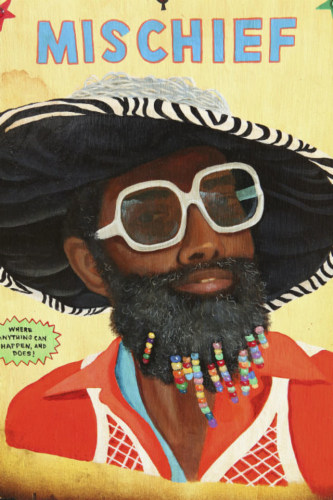
Dr. Buzzard, Domingo the Black Constable, Gullah Jack the Conjurer—these are the names that hover over the history of Hoodoo, a spiritual practice that evolved across the African diaspora in the New World. Despite the dark monikers, the power wielded by these legends is (for the most part) a form of light, a complement to Christianity that grew up on plantations for cotton and sugarcane. There is no dominant Hoodoo or Vodou, but rather a number of creolized “conjure” traditions that differ by origin, from New Orleans to Charleston to the Caribbean.
For Reneé Stout, Hoodoo is a point of departure. “Tales of the Conjure Woman,” a sprawling survey of new work by the artist, marries the rootworker’s art with modernism. Stout’s art is hybrid, and a curator could choose half a dozen different ways to frame it. It appears that Mark Sloan, curator of the “Tales of the Conjure Woman,” never quite settled on one. (Sloan is director and senior curator of the Halsey Institute of Contemporary Art at the College of Charleston, which produced and co-organized the exhibit with the Museum of Fine Art at Spelman College and the Ruth and Elmer Wellin Museum of Art at Hamilton College.) No matter: Stout is enough of a force to drive an uncertain survey.
“The Rootworker’s Worktable” (2011) showcases the full range of concerns in Hoodoo magic (and Stout’s practice). Part sculpture, part installation, the piece is a bureau covered in mysterious vials and stoppered bottles. (Stout, who is a magpie, finds and collects these things from botánicas and other such shops, but her works can be deceptive: Many things that look found in her art, she in fact makes by hand.) In place of several drawers, the chest features vintage in-set dials, meters, and what might be an old tube television set—all part of a creole steampunk aesthetic that Stout has adopted in recent years. The top of the bureau is illuminated, lending light and power to the installation of perfumes, potions, and secrets.
Over the bureau hangs a chalkboard covered in notes, spells, and most important of all, narrative. It’s a to-do list for a practical rootworker: “Important Roots,” “Remember to Gather,” and “The Properties of High John the Conqueror Root,” along with a diagram of the human heart, are listed among the field notes. “Things I’ll Need for the Seduction of Sterling Rochambeau”—here’s where things get spicy. (Ginseng, finger grass, lady’s slipper orchid, saffron, vanilla, and vetiver are some of the more practical listed ingredients; one should not overlook “black lacy bra and panties,” either.)
Many of Stout’s works manage to accomplish as much as “The Rootworker’s Worktable,” which spins an arresting story. Her work is never didactic or historical. Yet the American University Museum doesn’t do justice by this piece—or dozens of other photos, collages, and installations like it. As with virtually every show at the museum (including Maggie Michael’s mid-career survey on the third floor), “Tales of the Conjure Woman” is simply overcrowded. Ideally, the museum would’ve given each of these artists (Michael and Stout) half of the building, instead of shoehorning these surveys in with still other exhibitions (all work by women artists). Three major shows would have been stretching it; the American University Museum is hosting four.
Moreover, though, “Tales of the Conjure Woman” should have made for an irresistible opportunity for a curator. Her work is passionate, clever, charming, and threaded through with politics, dignity, and mystery—and yes, the show conveys those qualities. But it does not indulge in them. “Tales of the Conjure Woman” is careful, plain, over-lit, conservative, and cautious—all things that Stout’s work is not.
“What Reverend Beach Said,” a photo of a sign posted outside a small, dilapidated church hints at the legacy of the Southern Gothic in art. (The sign reads: “Reverend Beach said stay away from Fatima & Hoodoo! Don’t get no readings”—surely the sort of warning that a pastor might post in a Flannery O’Connor novel, or for that matter, outside any small-town fundamentalist Protestant church.) Squaring this somber photo with “The House of Chance and Mischief” (2008–10), a funkadelic, clock-like, tower-shaped sculpture of Robert Rauschenberg–esque odds and ends, is a tall order—they could be works by entirely different artists. This exhibit doesn’t make an argument. Simply seeing so much of Stout’s work is edifying in the end. “Tales of a Conjure Woman” doesn’t give the viewer enough tools to understand her work in its historical context, and it doesn’t take the risks it ought to with format and presentation. Stout’s stuff sells itself: roots and bones, candles and oils, lust and fury. Viewers who look closely will find an artist who is engaging as deeply with postwar art practices as she is the African diaspora, even if this museum show doesn’t make it easy.